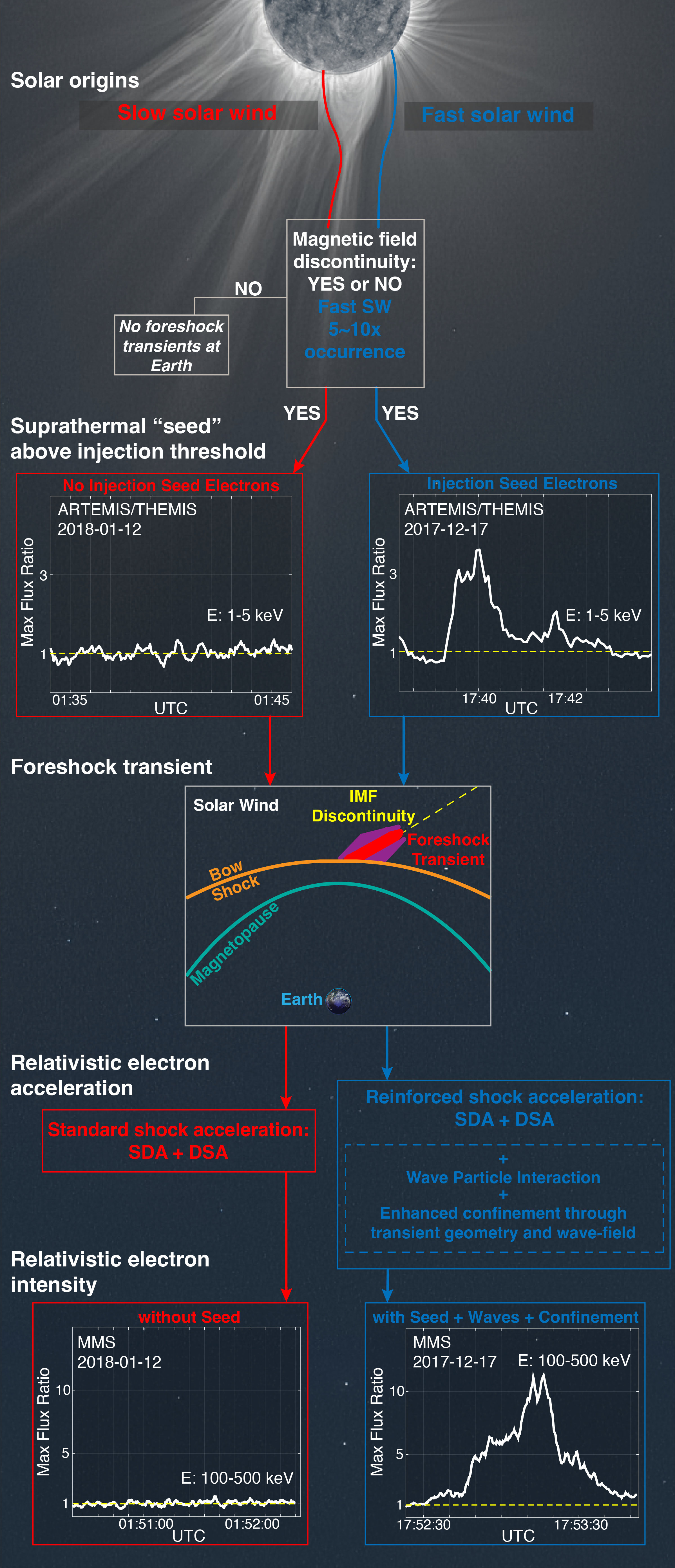2024 ARTEMIS SCIENCE NUGGETS
Revealing an unexpectedly low electron injection threshold via reinforced shock acceleration
by Savvas Raptis
The Johns Hopkins University Applied Physics Laboratory (JHU/APL)
Introduction
Collisionless shocks, generated by the interplay of charged particles and electromagnetic fields, are ubiquitous throughout the Universe. These powerful phenomena act as natural particle accelerators, energizing particles to relativistic speeds. One of the most intriguing examples occurs when the solar wind, a stream of charged particles from the Sun, collides with Earth's magnetic field, creating a shockwave known as the bow shock. To be efficiently accelerated by these shocks, electrons need to be pre-energized. However, the mechanism by which they reach the necessary energy levels remains a puzzle. This is known as the "electron injection problem." Understanding this process is crucial to unraveling the mysteries of cosmic ray origins and the dynamics of high-energy phenomena across the universe.
Results
Our research tries to address this problem by using data from NASA's MMS and THEMIS/ARTEMIS missions. By analyzing data from both missions, we revealed a fascinating process that accelerates electrons to incredibly high speeds near Earth. We focused on special structures called "foreshock transients," which are like transient bubbles of plasma. These transient phenomena form when the magnetic field embedded in the solar wind has a sharp change (called discontinuity) and interacts with the bow shock. What makes these transients unique is that they possess a smaller scale shock along with a core filled with electromagnetic waves, creating ideal conditions for electrons to gain energy.
| Figure 1. Time series data from the MMS spacecraft during the most energetic foreshock transient. (a) magnetic field components and magnitude (b) plasma densities, (c) plasma velocity components and magnitude, (d) high-energy electron spectra, (e) low-mid energy electron spectra, (f) ion spectra, (g) energy flux between 100 and 500 keV, (h) spectral index. Special indication is highlighting the core of the foreshock transient which is characterized by intense electromagnetic wave activity, as evidenced by the rapidly changing magnetic field lines in panel (a). A small-scale shock is shown by the sharp increase in both magnetic field strength and density in panels (a) and (b). The presence of relativistic electrons is evident in the enhanced fluxes observed in panels (d) and (g). Finally, the energy spectral index reaches a value of -2 in panel (h), highlighting the efficient acceleration occurring within this dynamic environment. Adapted from Figure 1 of Raptis et al., 2025. |
However, we discovered that not all transients are created equal. A key factor was revealed by analyzing THEMIS/ARTEMIS data which provide a direct characterization of the near-Earth solar wind conditions. We found that associated with the most energetic foreshock transients observed by MMS, there was a distinct presence of a "seed" population of lower-energy (suprathermal ~ 1KeV) electrons, carried by fast-moving solar wind streams originating from the Sun's coronal holes. These seed electrons get a boost from the foreshock transient phenomena and their interplay with the planetary bow shock. This process, combining shock acceleration and wave-particle interactions, can push electrons to relativistic speeds, exceeding 500 keV. Our findings provide a compelling explanation for how electrons gain enough energy to reach relativistic energies and offer valuable insights into particle acceleration mechanisms operating throughout the universe.
Conclusion
Our research presents through multiple events observed by both THEMIS/ARTEMIS and MMS a multiscale process that starts with fast particles from the Sun and ends with relativistic electrons at Earth's bow shock. These electrons interact with explosive transient plasma bubbles, where shocks, waves, and confinement processes accelerate them to relativistic energies. This process, combining different acceleration mechanisms, can generate highly energetic electrons, potentially contributing to the cosmic ray population. The underlying physics is fundamental and occurs throughout the universe, making our model applicable to other planets in our solar system and even exoplanets around distant stars. In these exotic environments, the unique conditions could allow electrons to reach even higher energies than what we observe near Earth. Our findings not only provide a clearer picture of particle acceleration in the universe but also address practical concerns related to space weather, as energetic electrons can impact satellite operations and communication systems at Earth.
| Figure 2. This illustration summarizes how electrons can be accelerated to relativistic energies near Earth’s bow shock. The process starts with the Sun releasing a fast stream of particles carrying a "seed" population of energetic electrons (shown in blue). When this stream containing a magnetic field discontinuity encounters Earth's magnetic field, it creates a dynamic energy bubble called a foreshock transient. Inside this bubble, shocks and electromagnetic waves boost the electrons' energy. The magnetic field and the adjacent planetary bow s hock helps contain these energized electrons, allowing them to reach relativistic speeds. In contrast, when the Sun releases a slower stream of particles without the initial "seed" population (shown in red), this acceleration process is less effective. Adapted from Figure 4 of Raptis et al., 2025. |
References
Raptis, S., Lalti, A., Lindberg, M., Turner, D. L., Caprioli, D., and Burch, J. L. (2025). Revealing an unexpectedly low electron injection threshold via reinforced shock acceleration. Nature Communications, 16(1), 488.Raptis, S. (2025, January 18). How do relativistic electrons form at shocks? Research Communities by Springer Nature. https://communities.springernature.com/posts/how-do-relativistic-electrons-form-at-shocks
Biographical Notes
Savvas Raptis is a postdoctoral researcher at Johns Hopkins University Applied Physics Laboratory (JHU/APL). His research focuses on transient phenomena across the dayside and nightside magnetosphere, particle energization, and machine learning modeling.
 Please send comments/suggestions to
Emmanuel Masongsong / emasongsong @ igpp.ucla.edu
Please send comments/suggestions to
Emmanuel Masongsong / emasongsong @ igpp.ucla.edu
